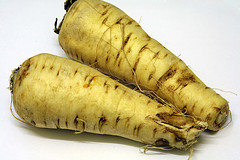Difference between revisions of "Parsnips"
(Created page with "{{Infobox_Vegetables | image = parsnips.jpg | carrying temperature = 0°C to 1°C | highest freezing point = -0,9°C | a...") |
|||
| Line 23: | Line 23: | ||
Rapid cooling to 5°C or below immediately after harvest is essential to minimise decay and moisture losses during extended storage. | Rapid cooling to 5°C or below immediately after harvest is essential to minimise decay and moisture losses during extended storage. | ||
| − | Parsnip roots can be stored 4 to 6 months at 0°C with 98% RH. Only healthy roots with no damage should be placed in storage. | + | Parsnip [[roots]] can be stored 4 to 6 months at 0°C with 98% RH. Only healthy roots with no damage should be placed in storage. |
| − | The high soluble sugar content (which tends to increase further during storage) causes a substantial depression in freezing point, so that parsnips generally do not freeze until about -2°C. | + | The high soluble [[sugar]] content (which tends to increase further during storage) causes a substantial depression in freezing point, so that parsnips generally do not freeze until about -2°C. |
==Controlled atmosphere considerations== | ==Controlled atmosphere considerations== | ||
| Line 37: | Line 37: | ||
| − | |||
[[Category:Perishables]] | [[Category:Perishables]] | ||
[[Category:Products]] | [[Category:Products]] | ||
Revision as of 17:26, 14 March 2012
| Infobox on Parsnips | |
|---|---|
| Example of Parsnips |  |
| Freshness facts | |
| Optimum carrying temperature | 0°C to 1°C |
| Highest freezing point | -0,9°C |
| Acceptable product temp. at loading into containers | Max. 2°C above carrying temperature |
| Optimum humidity | 95% to 100% |
| Ventilation setting for containers | 10 m³/hr |
| Storage life | 2 to 6 months |
| Climacteric / non-climacteric | Non-climacteric |
| Ethylene production | Very low |
| Ethylene sensitivity | Low |
| Modified / controlled atmosphere | - |
| Potential benefits | - |
| Availability | |
| On demand | |
Parsnips
Contents
Harvesting and Handling
The parsnip is in the same family as the carrot, but is less widely grown.
A high quality parsnip will be firm, reasonably clean and fairly smooth surfaced. Parsnips are topped after harvesting but should not be trimmed into the crown.
Cooling and Storage
Rapid cooling to 5°C or below immediately after harvest is essential to minimise decay and moisture losses during extended storage.
Parsnip roots can be stored 4 to 6 months at 0°C with 98% RH. Only healthy roots with no damage should be placed in storage.
The high soluble sugar content (which tends to increase further during storage) causes a substantial depression in freezing point, so that parsnips generally do not freeze until about -2°C.
Controlled atmosphere considerations
There are no benefits to controlled atmosphere storage.
Parsnips produce very low ethylene. Exposure to low levels of ethylene in cold storage causes bitterness.
Storage disorders
Bacterial soft rot, Black rot, Canker, Cavity spot, Fusarium, Licorice rot, Watery soft rot.











